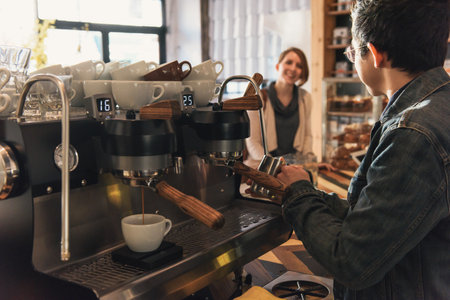The Coffee Shop as a Workspace: A Cultural Shift
Coffee shops have long been social hubs, but in the United States, they’ve evolved into something much more—an extension of the workplace. This transformation didn’t happen overnight; it reflects broader societal changes, including shifts in technology, work culture, and lifestyle preferences.
From European Cafés to American Coffeehouses
The concept of coffeehouses as places for discussion and creativity dates back centuries. In 17th-century Europe, cafés were often called “penny universities” because for the price of a coffee, patrons could engage in intellectual conversations. When this idea crossed over to America, it took on a new form—blending fast-paced service with a casual environment that encouraged lingering.
The Rise of Freelancers and Creative Professionals
In the early 2000s, as Wi-Fi became more widely available, freelancers—writers, designers, coders—began flocking to coffee shops. These spaces offered just enough noise to stimulate creativity without the distractions of home. Starbucks and other major chains leaned into this trend by offering free internet and comfortable seating.
Technology and the Remote Work Boom
With laptops becoming lighter and cloud-based tools more accessible, working from anywhere became a real option. The COVID-19 pandemic accelerated remote work culture across industries, turning coffee shops into unofficial offices for professionals who once spent their days in cubicles.
How Coffee Shops Became Workspaces
| Time Period | Key Changes | Impact on Coffee Shop Culture |
|---|---|---|
| Early 2000s | Widespread Wi-Fi access; rise of freelancers | Coffee shops become creative hubs |
| 2010s | Cloud computing; gig economy grows | More solo workers choose cafés as offices |
| 2020s | Pandemic-driven shift to remote work | Coffee shops serve as flexible workspaces for all kinds of professionals |
A Lifestyle Choice
Beyond functionality, working from a coffee shop has become part of the American lifestyle. It offers a sense of community without requiring direct interaction, a change of scenery from home offices, and access to caffeine-fueled productivity. In essence, its not just about where you work—its about how you live.
2. Freelancers and the Rise of the Laptop Lifestyle
Back in the early 2000s, a new kind of worker began showing up regularly at coffee shops across the U.S.—freelancers. With laptops in hand, they turned local cafés into their personal offices. This wasn’t just a passing trend; it marked the beginning of what many now call the “laptop lifestyle.”
Several factors drove this shift. First, technology had finally caught up—Wi-Fi was becoming more widely available, laptops were more affordable and portable, and cloud-based tools made working from anywhere possible. At the same time, the gig economy started to take root. Many workers were stepping away from traditional 9-to-5 jobs in favor of freelancing, consulting, or launching small businesses.
The appeal of working from a coffee shop was clear: flexible hours, a change of scenery, and just enough background noise to boost focus without being distracting. For freelancers, especially writers, designers, developers, and marketers, cafés became more than just places to grab a latte—they were productivity hubs that supported their non-traditional workstyle.
Why Coffee Shops Became Popular Workspaces
| Reason | Description |
|---|---|
| Mobility | Laptops and Wi-Fi allowed freelancers to work from anywhere, including their favorite café. |
| Flexibility | No strict office hours meant they could work when they were most productive. |
| Community Feel | Coffee shops offered social energy without direct interaction—ideal for solo workers. |
| Low Cost Workspace | A cup of coffee was often cheaper than renting an office space. |
| Creative Inspiration | The atmosphere helped boost creativity and motivation for many freelancers. |
This era laid the foundation for today’s remote work culture. As more people sought autonomy over how and where they worked, coffee shops evolved to meet their needs—adding power outlets, offering stronger Wi-Fi, and even creating designated coworking areas in some locations.

3. Tech Boom and Startup Culture
As the tech industry started to explode in the early 2000s, coffee shops quickly became more than just a spot for freelancers and students. They evolved into informal offices for tech workers, startup founders, and small development teams. With free Wi-Fi, plenty of caffeine, and a relaxed atmosphere, these spaces offered the perfect blend of comfort and creativity.
Why Coffee Shops Became Popular Among Tech Workers
Tech professionals found that working from a coffee shop provided a break from traditional office environments without sacrificing productivity. The ambient noise, steady energy of people coming and going, and easy access to food and drinks made it easier to focus and collaborate.
Common Activities in Coffee Shops by Startup Teams
| Activity | Description |
|---|---|
| Code Jams | Developers gathered to write code together, solve bugs, or build prototypes in real-time. |
| Brainstorming Sessions | Teams sketched out ideas on laptops or notepads, bouncing creative concepts off each other over coffee. |
| Team Meetings | Startups held casual meetings to discuss progress, goals, or pitch decks in a low-pressure environment. |
Coffee Shops as Innovation Hubs
This new wave of remote-friendly culture turned coffee shops into unofficial incubators for innovation. Some of the earliest ideas for popular apps and startups were first scribbled down at café tables. In cities like San Francisco, Seattle, and Austin, it wasn’t uncommon to see a table full of entrepreneurs pitching ideas next to someone debugging code.
The Role of Environment in Creativity
The open layout, casual vibe, and diversity of people in coffee shops helped spark unexpected collaborations. Designers could meet developers organically. Writers might connect with marketers. These spaces created an energy that couldnt always be replicated in traditional office settings.
Key Takeaway
Coffee shops weren’t just convenient—they became essential spaces where startup culture thrived. By offering flexibility and inspiration outside corporate walls, they played a big role in shaping today’s remote work movement.
4. COVID-19 and the Remote Work Revolution
The COVID-19 pandemic reshaped how and where we work, almost overnight. Offices shut down, companies went fully remote, and millions of people found themselves navigating work from home for the first time. While some enjoyed the flexibility, others quickly realized that working from a kitchen table or bedroom wasn’t always ideal. That’s where coffee shops stepped in as more than just a place to grab a latte—they became essential third spaces for remote workers.
Why Coffee Shops Became Popular During Remote Work
Coffee shops offered something many homes couldn’t: a change of scenery, background noise that helped with focus, and a sense of community—even if it was just being around other people. As lockdowns eased, people sought out these environments to escape isolation and reclaim productivity.
Key Reasons People Chose Coffee Shops for Remote Work
| Reason | Description |
|---|---|
| Reliable Wi-Fi | Most coffee shops upgraded their internet to attract remote workers looking for stable connections. |
| Ambient Atmosphere | The natural buzz of conversations and espresso machines helped mimic an office-like environment. |
| No Household Distractions | Getting away from chores, kids, or roommates helped many focus better on their tasks. |
| Mental Health Boost | Being around others—even strangers—helped reduce feelings of isolation during uncertain times. |
How Coffee Shops Adapted to the New Normal
To meet the needs of this new wave of remote workers, many coffee shops made intentional changes:
1. Layout Adjustments
Seating was rearranged to allow for social distancing while still offering power outlets and comfortable spaces for laptops.
2. Extended Hours
Some cafes opened earlier or stayed open later to accommodate flexible work schedules.
3. Loyalty Programs for Regulars
Frequent visitors were rewarded with discounts or perks like reserved seating or priority Wi-Fi access.
4. Menu Updates
Cafes introduced healthier meal options and all-day breakfast items to cater to longer stays and changing routines.
Coffee Shops as Modern-Day “Third Places”
Sociologists call them “third places”—spaces that are neither home nor work but serve a social function in our lives. With offices closed and homes becoming overwhelming, coffee shops filled that gap. They weren’t just about caffeine anymore; they became places where people could feel connected, focused, and even inspired during one of the most disruptive times in modern history.
This shift wasn’t just temporary—it laid the groundwork for a long-term cultural change in how we view work environments and where we choose to be productive outside traditional office settings.
5. The Modern Remote Worker: Expectations and Etiquette
As coffee shops continue to evolve into unofficial coworking spaces, remote workers are redefining what it means to work outside a traditional office. But with this freedom comes a set of unspoken rules that help maintain a respectful and productive environment for everyone — customers, baristas, and fellow laptop warriors alike.
Respect the Space
Coffee shops are first and foremost businesses. While they welcome people working from their tables, it’s important to remember that your workspace is also someone elses dining area. If youre planning to stay for more than an hour or two, it’s good etiquette to make small purchases throughout your visit. A single $4 latte shouldn’t be your only buy during a four-hour work session.
Suggested Purchases Based on Stay Duration
| Stay Duration | Recommended Purchases |
|---|---|
| Up to 1 hour | One drink (coffee, tea, etc.) |
| 1–3 hours | Drink + snack or light meal |
| 3+ hours | At least two purchases or a meal + drink refill |
Mind the Wi-Fi and Power Usage
Wi-Fi is often seen as a modern essential, but remember: its not guaranteed. Always check if theres a time limit or if you need to ask for a password. Overloading the connection by streaming video or downloading large files can slow things down for everyone.
Power outlets are another hot commodity. Don’t hog multiple sockets or unplug others without asking. If outlets are limited, consider bringing a portable charger or power strip (and offer to share!).
Keep It Low-Key
Coffee shops have their own vibe — usually relaxed and moderately quiet. Take phone calls outside when possible, avoid loud Zoom meetings in public spaces, and use headphones if you’re listening to music or watching videos.
Coffee Shop Audio Etiquette Checklist:
- Use headphones at all times when playing audio.
- Keep call volume low — step outside if needed.
- Avoid video calls unless absolutely necessary.
- No speakerphone — ever.
Clean Up After Yourself
This might seem obvious, but its worth repeating: throw away trash, return dishes if required, and leave your table clean for the next customer. You’re not just working here — youre part of the spaces shared community.
The Balance Between Productivity and Courtesy
Remote workers rely on coffee shops for focus and inspiration, but maintaining good etiquette ensures these spaces remain welcoming for everyone. Being mindful of your impact helps build goodwill — both with staff and other customers — and keeps the doors open for future working sessions over your favorite brew.
6. What’s Next: Rethinking Public Workspaces
Coffee shops have become more than just spots to grab a latte—theyre now unofficial offices for freelancers, digital nomads, and remote workers. But as hybrid work continues to evolve, whats next for these public workspaces? The future may hold a more intentional approach from both coffee shop owners and workers who rely on these environments.
The Rise of the “Third Place”
In American culture, the idea of a “third place”—a space outside home and office—has long been important for community and connection. Coffee shops fit this role perfectly, offering comfort, Wi-Fi, and a social buzz that fuels productivity. As more companies adopt flexible work models, the demand for welcoming, functional third places is expected to grow.
Designing for the Remote Workforce
Coffee shop owners are starting to rethink how their spaces can better serve long-term remote workers. Instead of just tables and chairs, we may see features like:
| Feature | Purpose |
|---|---|
| Dedicated Work Zones | Separate areas with minimal noise and power outlets for focused tasks |
| Membership or Loyalty Programs | Encourage regulars by offering Wi-Fi upgrades, discounts, or reserved seating |
| Soundproof Pods or Booths | Support video calls or meetings without disturbing others |
| Ergonomic Seating | Make long work sessions more comfortable and healthy |
| Extended Hours | Accommodate different time zones and flexible schedules |
A Win-Win for Businesses and Workers
This shift benefits both sides. Remote workers get an inspiring space away from home distractions, while coffee shops gain consistent foot traffic and brand loyalty. In fact, some businesses might even partner with local cafes to provide “satellite offices” for employees without needing a full co-working subscription.
Possible Future Collaborations
- Tech Companies & Cafes: Offering employees monthly credits to spend at approved locations.
- Remote Teams: Hosting casual meetups at coffee shops instead of formal office spaces.
- Cafes & Designers: Working together to optimize layout, acoustics, and amenities for productivity.
The Bottom Line
Coffee shops are no longer just a pit stop—theyre becoming a key part of the remote work ecosystem. As hybrid work becomes the norm in America, expect these spaces to adapt in creative ways that support connection, flexibility, and daily routines.


